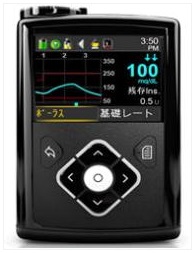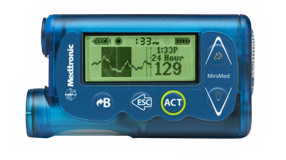
Tips for buying Insulin Pump
Minimed 620g 630g 640g And 670g Insulin Pumps
FCC ID application submitted by Medtronic MiniMed, Inc. For 620G/630G/640G/670G Insulin Delivery Pump for FCC ID OH21510 ( OH2 1510 ) User Manual, Frequency, Reports, Images and more. 2020年07月06日 ミニメド620gインスリンポンプご使用の皆様へ 新型コロナウイルス感染拡大の影響を受けた 本人または生計維持者の失業のため 弊社製品を用いた糖尿病治療が継続できないみなさまへの支援について (2020年07月06日掲載). Windows 7 games for windows 10 download. Arcgis 10.3 crack download windows 10.
- Medtronic is warning people who use MiniMed 620G, 630G, 640G and 670G insulin pumps that the devices may deliver too much or not enough insulin if an exterior mechanical component on the top of.
- September 2015 - FDA Class 2 Recall on MiniMed 620G Insulin Pump June 2015 - FDA Class 2 Recall on Medtronic MiniMed September 2017 - Voluntary Recall of Diabetes Infusion Sets November 2019 – FDA Class 1 Recall on MiniMed Models 630G and 670G.
- 1510 620g/630g/640g/670g Insulin Delivery Pump User Manual Users Manual 5 Medtronic Minimed, Inc. 1510 620G/630G/640G/670G Insulin Delivery Pump User Manual Users Manual 5 Medtronic MiniMed, Inc. Medtronic MiniMed, Inc. 620G/630G/640G/670G Insulin Delivery Pump Trouble Viewing?
- These units are used to deliver parenteral agents from syringes or collapsible bags. Their size should be small enough so that patients would comfortably wear or carry them. During sleep they should not disturb the patient, and during daily use they should not be conspicuous.
- Facilities should carefully select patients to ensure successful insulin infusion therapy. The patients should be motivated and mature with a history of good compliance with insulin therapy.
- All pumps should be able to run for at least 72 hours without draining the reservoir or depleting the batteries. Pumps should have a flow range of <=0.5 to >=100 mL/hr and maintain a flow accuracy of 5%. Ambulatory pumps should be capable of operating in a continuous infusion mode, though it is desirable for pumps to offer additional modes.
- Luer-lock fittings or integral tubing, distal air filters, and air in line detectors may be used as protection methods against air embolism in ambulatory infusion and ambulatory insulin pumps that can deliver from an external reservoir.
- Pumps should detect an upstream occlusion and suspend infusion when downstream pressure is >=10 psi. The bolus volume released after an occlusion is cleared should be 0.5 mL.
- Free flow protection should be part of any ambulatory and ambulatory insulin infusion pumps. Audible alarms should sound for all conditions that might interrupt infusion, including high pressure/occlusion, low or depleted battery, reservoir-side obstruction, pump malfunction, air in line, and empty or near empty reservoir.
- Alarm volume should be adjustable with settings loud enough for critical alarms and soft enough for social situations. The pumps should have data logs that can store up to 200 events including volume delivered, program settings, error codes, alarms, and rate.
- Display screens in ambulatory insulin infusion pumps should be clear and easy to read and should indicate time, basal rate, bolus dose, and accumulated dose.
- All ambulatory insulin infusion pumps offered should be able to deliver basal flows of 5 to 100 U/day with a resolution of 2 U/day. The recommended ones are those with a bolus dose range of <=0.5 to >=25 U/bolus with a resolution of <=0.5 units.

Medtronic Minimed 620g

Tips for buying Insulin Pump
Minimed 620g 630g 640g And 670g Insulin Pumps
FCC ID application submitted by Medtronic MiniMed, Inc. For 620G/630G/640G/670G Insulin Delivery Pump for FCC ID OH21510 ( OH2 1510 ) User Manual, Frequency, Reports, Images and more. 2020年07月06日 ミニメド620gインスリンポンプご使用の皆様へ 新型コロナウイルス感染拡大の影響を受けた 本人または生計維持者の失業のため 弊社製品を用いた糖尿病治療が継続できないみなさまへの支援について (2020年07月06日掲載). Windows 7 games for windows 10 download. Arcgis 10.3 crack download windows 10.
- Medtronic is warning people who use MiniMed 620G, 630G, 640G and 670G insulin pumps that the devices may deliver too much or not enough insulin if an exterior mechanical component on the top of.
- September 2015 - FDA Class 2 Recall on MiniMed 620G Insulin Pump June 2015 - FDA Class 2 Recall on Medtronic MiniMed September 2017 - Voluntary Recall of Diabetes Infusion Sets November 2019 – FDA Class 1 Recall on MiniMed Models 630G and 670G.
- 1510 620g/630g/640g/670g Insulin Delivery Pump User Manual Users Manual 5 Medtronic Minimed, Inc. 1510 620G/630G/640G/670G Insulin Delivery Pump User Manual Users Manual 5 Medtronic MiniMed, Inc. Medtronic MiniMed, Inc. 620G/630G/640G/670G Insulin Delivery Pump Trouble Viewing?
- These units are used to deliver parenteral agents from syringes or collapsible bags. Their size should be small enough so that patients would comfortably wear or carry them. During sleep they should not disturb the patient, and during daily use they should not be conspicuous.
- Facilities should carefully select patients to ensure successful insulin infusion therapy. The patients should be motivated and mature with a history of good compliance with insulin therapy.
- All pumps should be able to run for at least 72 hours without draining the reservoir or depleting the batteries. Pumps should have a flow range of <=0.5 to >=100 mL/hr and maintain a flow accuracy of 5%. Ambulatory pumps should be capable of operating in a continuous infusion mode, though it is desirable for pumps to offer additional modes.
- Luer-lock fittings or integral tubing, distal air filters, and air in line detectors may be used as protection methods against air embolism in ambulatory infusion and ambulatory insulin pumps that can deliver from an external reservoir.
- Pumps should detect an upstream occlusion and suspend infusion when downstream pressure is >=10 psi. The bolus volume released after an occlusion is cleared should be 0.5 mL.
- Free flow protection should be part of any ambulatory and ambulatory insulin infusion pumps. Audible alarms should sound for all conditions that might interrupt infusion, including high pressure/occlusion, low or depleted battery, reservoir-side obstruction, pump malfunction, air in line, and empty or near empty reservoir.
- Alarm volume should be adjustable with settings loud enough for critical alarms and soft enough for social situations. The pumps should have data logs that can store up to 200 events including volume delivered, program settings, error codes, alarms, and rate.
- Display screens in ambulatory insulin infusion pumps should be clear and easy to read and should indicate time, basal rate, bolus dose, and accumulated dose.
- All ambulatory insulin infusion pumps offered should be able to deliver basal flows of 5 to 100 U/day with a resolution of 2 U/day. The recommended ones are those with a bolus dose range of <=0.5 to >=25 U/bolus with a resolution of <=0.5 units.
Medtronic Minimed 620g
|
Minimed 620g Insulin Pump
Minimed 620g System
| |||||||||||||||||||||||||||
| Medtronic sent an Urgent Medical Device Recall Notification dated September 2015, to all affected customers. The letter identified the product the problem and the action needed to be taken by the customer. The letters stated that the pump drive motors may experience a malfunction which would result in a pump error message alarm notifying the patient that insulin is no longer being delivered. The letters also inform the customers of what actions are to be taken. Customers with questions are instructed to contact Medtronic MiniMed's customer support team. For further questions please call (818) 576-4700. | |||||||||||||||||||||||||||
|---|---|---|---|---|---|---|---|---|---|---|---|---|---|---|---|---|---|---|---|---|---|---|---|---|---|---|---|
| 53 units | |||||||||||||||||||||||||||
| Internationally Distribution only to the countries of : Australia, Austria, Belgium, Chile, Czech Republic, Denmark, Finland, France, Germany, Greece, Iceland, India, Ireland, Italy, Japan, Kenya, Luxembourg, Namibia, Netherlands, Norway, Slovenia, South Africa, Spain, Sweden, Switzerland, United Kingdom. | |||||||||||||||||||||||||||
| TPLC Device Report | |||||||||||||||||||||||||||
| 1 A record in this database is created when a firm initiates a correction or removal action. The record is updated if the FDA identifies a violation and classifies the action as a recall, and it is updated for a final time when the recall is terminated. Learn more about medical device recalls. 2 Per FDA policy, recall cause determinations are subject to modification up to the point of termination of the recall. 3 For details about termination of a recall see Code of Federal Regulations (CFR) Title 21 §7.55. |
